Pruning Hydrangeas
Taking the mystery out of pruning hydrangeas
Return to Trees and Shrubs Agent Articles
By Dennis Patton, horticulture agent
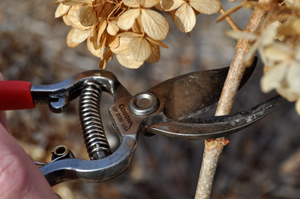 Hydrangeas have long been popular in the landscape. They have an allure. It’s as if they speak to us, saying, “Come plant me; enjoy me in the garden.” Resisting the temptation is hard. Once planted confusion sets in about proper care, especially pruning. How, when, where are common questions received at Johnson County K-State Research and Extension. Let’s attempt to unravel the confusion surrounding pruning this plant.
Hydrangeas have long been popular in the landscape. They have an allure. It’s as if they speak to us, saying, “Come plant me; enjoy me in the garden.” Resisting the temptation is hard. Once planted confusion sets in about proper care, especially pruning. How, when, where are common questions received at Johnson County K-State Research and Extension. Let’s attempt to unravel the confusion surrounding pruning this plant.
Hydrangea macrophylla
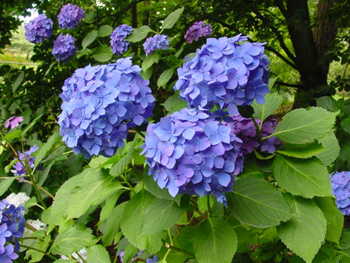 These big leaf or mophead hydrangeas are the most popular. They have big rounded pink or blue blooms. These are the classic hydrangea. Popular varieties include the Endless Summer Series, Cityline Series and the Let’s Dance Series.
These big leaf or mophead hydrangeas are the most popular. They have big rounded pink or blue blooms. These are the classic hydrangea. Popular varieties include the Endless Summer Series, Cityline Series and the Let’s Dance Series.
Mopheads bloom best on old growth, as the buds are set the previous fall, overwinter and open the following spring. Many varieties set a secondary flower bud which flowers in late summer. Early spring pruning should be limited to only dead wood. Cutting into healthy buds results in the removal of potential flowers. Controlling plant size and shape are accomplished after flowering. This allows time for the fall bloom and next year’s bud to develop.
Hydrangea arborescens
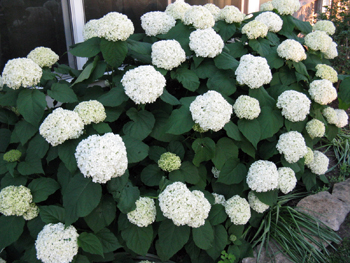 This group is best known by the popular variety, Annabelle or the smooth leaf hydrangea. Other varieties are Invincibelle Spirit and Incrediball. Unlike the big leaf hydrangeas this group blooms on new spring growth.
This group is best known by the popular variety, Annabelle or the smooth leaf hydrangea. Other varieties are Invincibelle Spirit and Incrediball. Unlike the big leaf hydrangeas this group blooms on new spring growth.
Smooth leaf hydrangeas are the easiest to grow. Pruning is simple. Cut the old stems back to just above the lowest plump bud above the ground every spring. Harsh pruning brings big rewards. Each trimmed stem leads to a sturdy stem capped off with a big rounded flower in either white or pink, depending on the variety.
Hydrangea paniculata
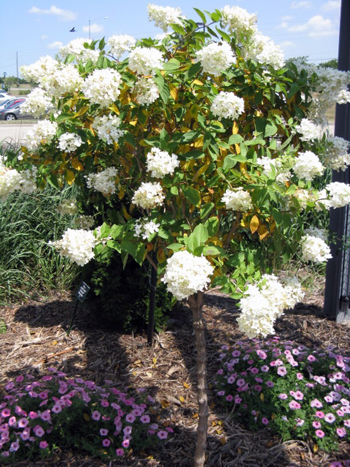 Panicle hydrangeas flower in white with some tinges of pink. The flowers usually are rounded with an elongated point. Popular varieties are Limelight, Quickfire, Tardiva, Pinky Winky and Vanilla Strawberry.
Panicle hydrangeas flower in white with some tinges of pink. The flowers usually are rounded with an elongated point. Popular varieties are Limelight, Quickfire, Tardiva, Pinky Winky and Vanilla Strawberry.
This easier group blooms on new growth that is produced in the spring and early summer. Flowering starts in July and can last through August. Pruning is done in the early spring when breaking bud. Panicle types can get large. More pruning leads to bigger flower heads. Cut back the growth to a bud about two feet from the ground. Remove pencil size wood as it takes a sturdy branch to hold a big flower.
Hydrangea quercifolia
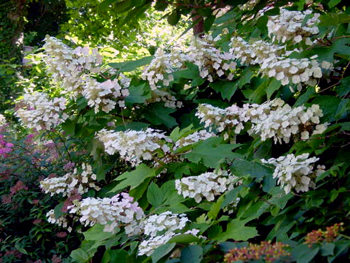 Oakleaf hydrangeas are a classic. These plants have deeply lobed leaves and long showy spring flowers. Varieties on the market include Alice, Snow Queen, Sikes Dwarf, Pee Wee, and Ruby Slippers.
Oakleaf hydrangeas are a classic. These plants have deeply lobed leaves and long showy spring flowers. Varieties on the market include Alice, Snow Queen, Sikes Dwarf, Pee Wee, and Ruby Slippers.
These spring bloomers produce their flowers on old growth, like the macrophylla group. This means little or no pruning happens in the spring. Remove dead twigs, enjoy the flowers and then do the bulk of pruning after the show wanes.
The best advice is to limit pruning all together. Oakleaf’s have beautiful cinnamon colored bark that peels and is quite ornamental. Heavy pruning reduces winter interest. Be warned; some of these varieties get big — over eight feet.
Still confused? Don’t hesitate to contact Johnson County Extension’s Gardening Hotline, 913-715-7050 or garden.help@jocogov.org.
Other Resources

Have questions? The Garden Hotline is staffed by trained EMG volunteers and Extension staff who will assist you with questions.
Phone: (913) 715-7050
Email: garden.help@jocogov.org